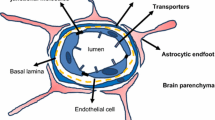Abstract
The blood-brain barrier (BBB) symbolically represents the gateway to the central nervous system. It is a single layer of specialized endothelial cells that coats the central nervous system (CNS) vasculature and physically separates the brain environment from the blood constituents to maintain the homeostasis of the CNS. However, this protective measure is a hindrance to the delivery of therapeutics to treat neurological diseases. Here, we show that activation of A2A adenosine receptor (AR) with an FDA-approved agonist potently permeabilizes an in vitro primary human BBB (hBBB) to the passage of chemotherapeutic drugs and T cells. T cell migration under AR signaling occurs primarily by paracellular transendothelial route. Permeabilization of the hBBB is rapid, time-dependent, and reversible and is mediated by morphological changes in actin-cytoskeletal reorganization induced by RhoA signaling and a potent downregulation of claudin-5 and VE-cadherin. Moreover, the kinetics of BBB permeability in mice closely overlaps with the permeability kinetics of the hBBB. These data suggest that activation of A2A AR is an endogenous mechanism that may be used for CNS drug delivery in human.







Similar content being viewed by others
References
Deeken JF, Loscher W (2007) The blood-brain barrier and cancer: transporters, treatment, and Trojan horses. Clin Cancer Res 13:1663–1674
Abbott NJ, Ronnback L, Hansson E (2006) Astrocyte-endothelial interactions at the blood-brain barrier. Nat Rev Neurosci 7:41–53. doi:10.1038/nrn1824
Giacomini KM (2010) Membrane transporters in drug development. Nat Rev Drug Discov 9:215–236. doi:10.1038/nrd3028
Pardridge WM (2005) The blood-brain barrier: bottleneck in brain drug development. NeuroRx 2:3–14
Ribatti D, Nico B, Crivellato E, Artico M (2006) Development of the blood-brain barrier: a historical point of view. Anat Rec B New Anat 289:3–8
Hossain S, Akaike T, Chowdhury EH (2010) Current approaches for drug delivery to central nervous system. Curr Drug Deliv 7:389–397
Blackburn MR, Vance CO, Morschl E, Wilson CN (2009) Adenosine receptors and inflammation Handb Exp Pharmacol:215-269 doi:10.1007/978-3-540-89615-9_8
Hasko G, Linden J, Cronstein B, Pacher P (2008) Adenosine receptors: therapeutic aspects for inflammatory and immune diseases. Nat Rev Drug Discov 7:759–770. doi:10.1038/nrd2638
Jacobson KA, Gao ZG (2006) Adenosine receptors as therapeutic targets. Nat Rev Drug Discov 5:247–264
Fredholm BB APIJ, Jacobson KA, Linden J, Muller CE (2011) International Union of Basic and Clinical Pharmacology. LXXXI. Nomenclature and classification of adenosine receptors—an update. Pharmacol Rev 63:1–34. doi:10.1124/pr.110.003285
Carman AJ, Mills JH, Krenz A, Kim DG, Bynoe MS (2011) Adenosine receptor signaling modulates permeability of the blood-brain barrier. J Neurosci 31:13272–13280. doi:10.1523/JNEUROSCI.3337-11.2011
Mills JH, Alabanza L, Weksler BB, Couraud PO, Romero IA, Bynoe MS (2011) Human brain endothelial cells are responsive to adenosine receptor activation. Purinergic Signal 7:265–273. doi:10.1007/s11302-011-9222-2
Mills JH et al (2008) CD73 is required for efficient entry of lymphocytes into the central nervous system during experimental autoimmune encephalomyelitis. Proc Natl Acad Sci U S A 105:9325–9330. doi:10.1073/pnas.0711175105
Sohail MA et al (2009) Adenosine induces loss of actin stress fibers and inhibits contraction in hepatic stellate cells via Rho inhibition. Hepatology 49:185–194. doi:10.1002/hep.22589
Pollard TD, Cooper JA (2009) Actin, a central player in cell shape and movement science. Science 326:1208–1212. doi:10.1126/science.1175862
Spindler V, Schlegel N, Waschke J (2010) Role of GTPases in control of microvascular permeability. Cardiovasc Res 87:243–253
Li G et al (2010) Permeability of endothelial and astrocyte cocultures: in vitro blood-brain barrier models for drug delivery studies. Ann Biomed Eng 38:2499–2511
Carman CV, Springer TA (2008) Trans-cellular migration: cell-cell contacts get intimate. Curr Opin Cell Biol 20:533–540. doi:10.1016/j.ceb.2008.05.007
Wolburg H, Wolburg-Buchholz K, Engelhardt B (2005) Diapedesis of mononuclear cells across cerebral venules during experimental autoimmune encephalomyelitis leaves tight junctions intact. Acta Neuropathol 109:181–190. doi:10.1007/s00401-004-0928-x
Adamson RH (2002) Rho and rho kinase modulation of barrier properties: cultured endothelial cells and intact microvessels of rats and mice. J Physiol 539:295–308
Jaffe AB, Hall A (2005) Rho GTPases: biochemistry and biology. Annu Rev Cell Dev Biol 21:247–269. doi:10.1146/annurev.cellbio.21.020604.150721
Riento K, Ridley AJ (2003) Rocks: multifunctional kinases in cell behaviour. Nat Rev Mol Cell Biol 4:446–456. doi:10.1038/nrm1128
Tominaga T, Sahai E, Chardin P, McCormick F, Courtneidge SA, Alberts AS (2000) Diaphanous-related formins bridge Rho GTPase and Src tyrosine kinase signaling. Mol Cell
Rex CS, Chen LY, Sharma A, Liu J, Babayan AH, Gall CM, Lynch G (2009) Different Rho GTPase-dependent signaling pathways initiate sequential steps in the consolidation of long-term potentiation. J Cell Biol 186:85–97. doi:10.1083/jcb.200901084
Jeyaraj SC (2012) Cyclic AMP-Rap1A signaling activates RhoA to induce alpha(2c)-adrenoceptor translocation to the cell surface of microvascular smooth muscle cells. Am J Physiol Cell Physiol 303:C499–511. doi:10.1152/ajpcell.00461.2011
Bretscher A, Edwards K, Fehon RG (2002) ERM proteins and merlin: integrators at the cell cortex. Nat Rev Mol Cell Biol 3:586–599. doi:10.1038/nrm882
Wu MH (2005) Endothelial focal adhesions and barrier function. J Physiol 569:359–366. doi:10.1113/jphysiol.2005.096537
Stevenson BR, Keon BH (1998) The tight junction: morphology to molecules. Annu Rev Cell Dev Biol 14:89–109. doi:10.1146/annurev.cellbio.14.1.89
Hordijk PL, Anthony E, Mul FP, Rientsma R, Oomen LC, Roos D (1999) Vascular-endothelial-cadherin modulates endothelial monolayer permeability. J Cell Sci 112(Pt 12):1915–1923
Millan J (2010) Adherens junctions connect stress fibres between adjacent endothelial cells. BMC Biol 8:11. doi:10.1186/1741-7007-8-11
Adamson C, Kanu OO, Mehta AI, Di C, Lin N, Mattox AK, Bigner DD (2009) Glioblastoma multiforme: a review of where we have been and where we are going. Expert Opin Investig Drugs 18:1061–1083. doi:10.1517/13543780903052764
Wojciak-Stothard B, Ridley AJ (2002) Rho GTPases and the regulation of endothelial permeability. Vascul Pharmacol 39:187–199
Acknowledgments
This study was supported by National Institute of Health (NIH) Grant R01 NS063011 (to M.S.B.).
Author information
Authors and Affiliations
Corresponding author
Rights and permissions
About this article
Cite this article
Kim, DG., Bynoe, M.S. A2A Adenosine Receptor Regulates the Human Blood-Brain Barrier Permeability. Mol Neurobiol 52, 664–678 (2015). https://doi.org/10.1007/s12035-014-8879-2
Received:
Accepted:
Published:
Issue Date:
DOI: https://doi.org/10.1007/s12035-014-8879-2




